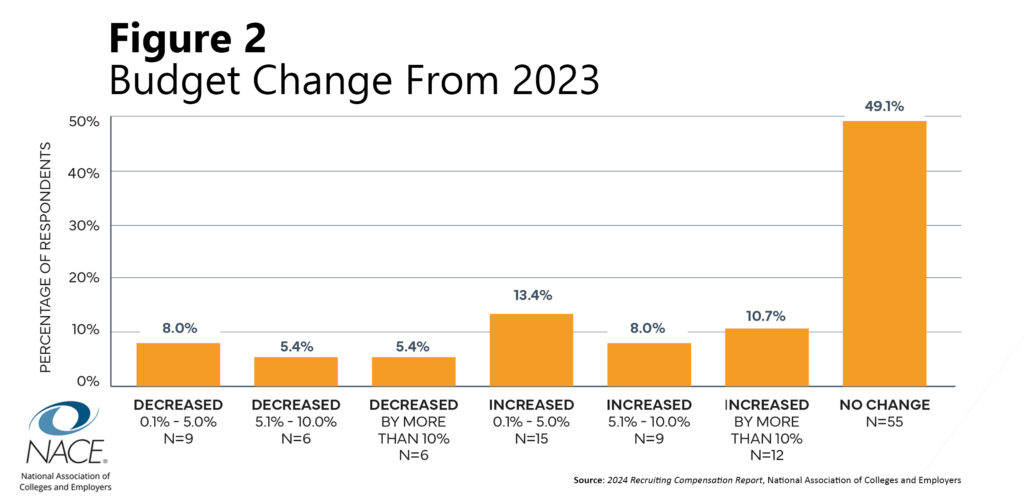Campus recruiting requires strategic budgeting: you’re competing for top & qualified college talent with constrained resources and high expectations. Seasoned talent-acquisition leaders know that a campus recruiting budget isn’t just a pile of cash – it must align with hiring goals, use data-driven insights. Yet many organizations fall into common traps.
Below, we outline seven frequent budgeting mistakes – grouped into themes like planning, technology investment, and measurement – and share how to avoid them with Rakuna’s recruitment budget template+.
1. Skipping Strategic Planning & Stakeholder Alignment

A top mistake is starting without a clear strategy or goals.
Too often, recruiters “just decide to hire more college grads” without a roadmap. Build your budget around a long-term vision: define whether you need interns, entry-level hires, or both, and what roles/departments will consume those hires. Involve key stakeholders early. Hiring managers and HR leaders should provide input well before budgets are finalized.
In fact, experts from Nonprofit Learning Lab recommend kicking off budget planning, which includes event & campus recruiting, at least three to six months before fiscal budgets close. As a campus recruitment leader, align with decision-makers on projected headcount and hiring criteria early, so you can strategically decide how many events to attend and how much to lean on other channels like direct outreach, career services, and digital campaigns to hit your hiring goals.
In short, having a data-backed recruiting plan and early stakeholder buy-in (support) ensures your budget funds the right activities at the right time.
2. Underestimating Total Costs (Hidden Expenses)

Another pitfall is forgetting “hidden” costs.
It’s easy to budget for the obvious line items (career fair booths, travel, job ads), but overlook indirect expenses. A classic example: the staff time you invest.
College Recruiter found that if a three-person campus team with a $250K combined salary hires 50 grads/year, just that salary alone adds $5,000 per hire.
- Add travel ($100K more = $2,000/hire),
- Events and swag ($100K = $2,000/hire),
Now your cost-per-hire can balloon to ~$9,000 if you count all components. Too many budgets omit internal labor and opportunity cost; don’t make that mistake.
Critical Task: When building your budget, list every expense:
- Travel & events: flight/hotel, booth fees, meals, and even productivity loss when staff are on the road.
- Technology: ATS fees, virtual event platforms, CRM subscriptions (see Mistake 3).
- Recruiter salaries: factor the percentage of recruiter time spent on campus hiring (e.g., if 50% of one recruiter’s time is devoted to campus, allocate half their comp to this budget).
- Marketing & swag: career fair materials, uniforms, giveaways (often low ROI – see below).
- Recruiting overhead: background checks, pre-employment screening, relocation, and any bonuses.
A useful tactic is to ask:
“Which steps are most expensive, and are we missing anything?”
For example, instead of printing hundreds of slick brochures and handouts that end up… well, in the campus recycling bin. Your team can host a “Portfolio Pitch Booth” where students can pitch their work (designs, coding projects, marketing campaigns, etc.) in 2–3 minutes for instant feedback or a chance at a fast-track interview.
This keeps candidates engaged for the same cost and even builds the employer brand. In practice, carefully tallying hidden costs can easily double or triple your budget estimates, so account for them up front
3. Ignoring High-ROI Technology Investments

In today’s market, manual processes are a budget drain. Yet many teams still schedule interviews by email chains, track candidates in spreadsheets, or send one-off emails instead of using tools. This is a recipe for inefficiency.
Modern recruiting tech – especially tools tailored for campus hiring – can slash costs and time. For instance, the Rakuna Interview Scheduling Software “automates the entire process,” eliminating back-and-forth with candidates. This frees recruiters from juggling calendars, meaning fewer scheduling errors, quicker hires, and more time/brain power for critical tasks.
Similarly, Rakuna Recruiting CRM lets you track every student through the hiring funnel. When you can see where candidates are in the hiring process at any point, your communication approach suddenly turns from reactive to proactive outreach. Instead of losing track of prospects or duplicating efforts, talent acquisition (TA) teams have been using CRM analytics to laser-focus on & nurture qualified leads at scale.

Text messaging is another powerful lever. Industry data from SlickText shows text recruiting is hugely effective. For example, companies using SMS see a 98% open rate (vs. ~20% for email); similarly, Mailchimp reported that 95% of texts are read within 4 minutes of being sent out.
In budget terms, faster fills and higher response rates mean you can scale hiring (or operate with fewer recruiters) for the same cost.
Bottom line: Neglecting tech is a missed opportunity. Allocating even a small portion of your budget to the right tools can pay off. Rakuna Text Recruiting, for example, enables mass personalized SMS outreach and analytics, so you can accelerate the hiring process with exponentially higher engagement.
In practice, invest in a solid scheduling solution and CRM, and expect gains in recruiter productivity and candidate experience. The ROI is well-established: any reduction in manual time or hiring cycle will quickly offset the subscription costs.
4. Focusing Only on Traditional In-Person Events

Many recruiters default to big in-person campus fairs as the core of their budget. While career fairs have value, over-reliance on them is a mistake, especially post-pandemic.
Today’s savvy TA teams adopt a hybrid strategy. Virtual and digital activities can reach more students at a lower cost. For example, digital career sessions and webinars can dramatically cut travel expenses: Instead of booking flights to 10 cities, a virtual campus tour lets hundreds of students attend online. This not only saves money but expands your reach to schools you otherwise might skip.
Likewise, employer branding and social media have replaced (or at least augmented) some traditional marketing spend. Gen Z students expect a strong online presence: blogs, short videos, TikTok, and Instagram engagement. Failure to budget for digital marketing is a mistake. Allocate dollars for targeted ads on social platforms and for branded content (videos, virtual Q&As), not just physical booths.
Another modern tactic is offering micro-internships or project-based experiences. The Parker Dewey webinar notes that short-term projects can be a “cost-effective way to evaluate candidates” while meeting real business needs. Budgeting a small stipend for a handful of micro-interns can yield pipelines of hire-ready graduates at a fraction of the typical onboarding cost.
Rakuna’s Campus & Event Recruitment Budget Template
Below is an illustrative recruitment budget template showing three tiers
Lean, Mid-Size, and Enterprise.
for a campus recruitment program. Allocations are based on industry best practices (e.g., Handshake’s recommendation that membership/platform fees run about 18–25% of your early-talent budget) and SHRM’s benchmark average cost-per-hire of $4,700.
Travel & events commonly consume ~30–40% of spend, tech/platforms ~20%, with the remainder split among marketing, swag, staff time, virtual events, and contingency.
| Category | Lean (≤500 employees, <200 hires) — $600K total | Mid-Size (500–5,000 employees, 200–1,000 hires) — $2M total | Enterprise (>5,000 employees, >1,000 hires) — $10M total |
|---|---|---|---|
| Staff Time & Salaries (recruiter effort) | 30% — $180,000 | 25% — $500,000 | 20% — $2,000,000 |
| Travel & Events (fair fees, lodging, F&B) | 30% — $180,000 | 25% — $500,000 | 20% — $2,000,000 |
| Technology & Platforms (ATS, CRM, virtual tools) | 15% — $90,000 | 15% — $300,000 | 20% — $2,000,000 |
| Marketing & Branding (ads, video, content) | 10% — $60,000 | 15% — $300,000 | 15% — $1,500,000 |
| Virtual Events & Webinars | 5% — $30,000 | 10% — $200,000 | 10% — $1,000,000 |
| Swag & Giveaways | 5% — $30,000 | 5% — $100,000 | 5% — $500,000 |
| Contingency / Buffer | 5% — $30,000 | 5% — $100,000 | 10% — $1,000,000 |
| Total | 100% — $600,000 | 100% — $2,000,000 | 100% — $10,000,000 |
How to read this template:
- Lean budgets (~$600K) suit small‐team programs (under 200 hires/year).
- Mid-Size allows for broader reach and more virtual/hybrid events.
- Enterprise budgets ( $10M+ ) support nationwide campus tours, premium tech stacks, and substantial CRM investments to manage large pipelines.
Note: SHRM’s latest data show an average cost-per-hire of $4,700. If you plan 100 campus hires, that implies $470K in total hiring cost alone—so this template’s $600K lean budget covers both CPH and support activities
5. Not Using Data to Set and Track Benchmarks

A surprisingly common mistake is building a budget without metrics. If you don’t know what outcomes you expect, you can’t assess ROI or adjust mid-stream. Start by identifying KPIs at each funnel stage.
- For example, track applicants → interviews → offers → hires. Parker Dewey recommends metrics like applicant-to-interview conversion and interview-to-hire ratios as actionable indicators.
- NACE also emphasizes formulas: the applicant-to-hire ratio (AHR) and campus interview-to-hire ratio (CIHR) clarify efficiency.
For instance, if you hold 50 campus interviews and make 5 hires, CIHR = 10 (ten interviews per hire) – a relatively high number. But doing just 10 interviews for 5 hires yields CIHR = 2 (much more efficient). Understanding these ratios helps allocate budget to channels that yield lower (better) ratios.
Key metrics to include in your budget model
Key metrics to include in your budget model are:
- Cost Per Hire (CPH): Total recruiting spend (all campuses, tech, travel, etc.) divided by number of hires from campus programs. Lower CPH is better – set targets and aim to beat them by optimizing spend.
- Time to Hire: Days from first contact with a student to offer acceptance. The Symplicity survey found 81% of students want hiring done within one month. If your timeline drifts longer, plan to adjust (e.g., by adding sourcing touchpoints or automation).
- Offer Acceptance Rate: % of extended offers that candidates accept. For interns, the average acceptance (offer rate) is about 62%, so expect roughly 6 out of 10 to be accepted. If your rate is much lower, you may be under-investing in candidate experience, offer competitiveness, or follow-up.
- Candidate Engagement Metrics: Track how many students engage at each stage (event attendance, info session RSVPs, application starts/completions, etc.). A high drop-off may indicate a process issue.
6. Overlooking Organization Scale and Segmentation

A one-size-fits-all budget approach is a mistake. Campus recruitment budgets should scale with your organization and hiring volume. A startup hiring 10 grads will have very different needs (and costs) than a Fortune 500 hiring 1,000 grads. Segment your budgeting by “tiers” of hiring velocity.
The mistake is not reflecting scale in your budget. Be sure to size each line item by volume. If you plan to interview 100 candidates instead of 10, doubling the booth budget won’t suffice; staff travel, hotel, coffee chats, and follow-ups all jump up. Conversely, small teams should avoid over-investing in areas they can’t capitalize on (e.g., large multi-city tours when only 20 hires are needed).
Creating tiers also helps when requesting approval. You can present a budget model showing ranges.
For example, the recruitment budget template above outlines rough benchmarks:
- Small TA teams under $1M
- Mid-size programs, a few million
- Enterprises much more (e.g, $30M for large pipelines, per Handshake estimates)
Such models clarify why you must spend more if hiring a lot, or how to trim costs if goals shrink. And if organizational headcount targets change, revisit this scaling: NACE found a third of organizations raised hiring budgets recently, while 20% cut them.
A nimble budget should adapt!
7. Building a Static Budget Without Contingency

The final mistake is treating your budget as a set-it-and-forget-it.
Recruitment is dynamic: student interest and business needs can shift. Economic downturns, campus seasonality, or an unexpected spike in requisitions all demand agility. Yet some teams draw up a budget in January and refuse to reallocate, even if mid-year data shows a clear need.
Avoid this by incorporating flexibility and contingency from the start. For example:
- Reserve a Buffer: Set aside ~5–10% of your budget for unplanned opportunities or emergencies (e.g., a last-minute need at a high-priority campus, or a sudden new college career fair you can’t skip).
- Regular Review: Plan quarterly budget reviews tied to hiring metrics. If you’re underspending in Q1 or Q2 (e.g., fewer interviews than expected), consider reallocating funds to Q3 virtual events or ramping up marketing. This is “proactive” forecasting – using real-time data to pivot before problems occur.
- Scenario Planning: What if offers are rejected at a higher rate than expected? If 62% of offers are accepted, then ~38% are declined. Budget time (and cost) to re-interview final-round candidates or sponsor late-stage campus events to top up the pipeline.
Putting this into practice means your budget isn’t a straitjacket. If new data shows a channel isn’t yielding hires, shift funds to a better one.
And remember your ROI model: if you’re coming in under target cost-per-hire, you can invest more in tools (like adding more texting blasts or premium virtual events). Conversely, if you’re overshooting, tighten non-essential spending (e.g., reduce swag).
Many organizations saw budget changes recently:
Remember the NACE report on budget change? In the last year, half reported flat budgets, ~30% increased, and ~20% cut back.

This volatility is a clear signal to build your budget to flex.
In summary, effective campus recruiting budgets are never afterthoughts – they’re living plans. By avoiding these mistakes, TA teams ensure every dollar works harder: strategy is aligned with business goals; all costs (including hidden ones) are accounted for; technology multiplies impact; and metrics guide decisions.

Team Rakuna
The Rakuna Team comprises a diverse group of professionals hailing from various corners of the world.
With a passion to enable organizations to hire their next waves of talents, we are dedicated to help organizations stay updated on important recruiting technology and industry best practices.


